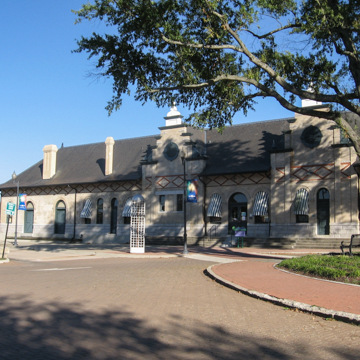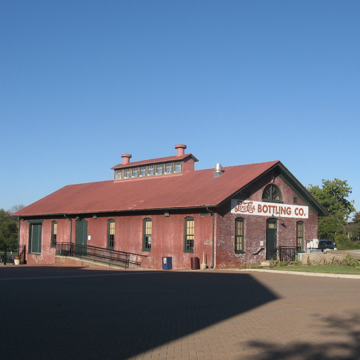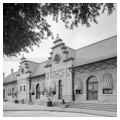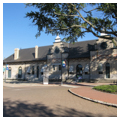You are here
Amtrak and Danville Science Center(Southern Railway Passenger Depot)
The railroad area on Craghead Street flourished after the 1894 consolidation of southern lines into the Southern Railway system. Designed by Milburn and built by Graham, the Southern's depot is a grand and improbable fusion of Romanesque Revival, Dutch Renaissance Revival, Victorian polychromatic surfaces, and linear railroad forms. The station was moved in 1915 because of a new track alignment, and following a fire in 1922 it was reconstructed very much to its original appearance except for the loss of its central tower. The round-arched windows of the entrance facade rest on a smooth granite belt course above a rough ashlar granite base with an outward batter. The buff-colored brick walls have prominent red brick diapering beneath the eaves. Paired stepped gables with buttress scrolls, a louvered bull's-eye, and a ball finial dominate the depot's facade. The steep hipped slate roof with kicked eaves, like the depot's linear form, is a common feature of late-nineteenth-century railroad architecture. The depot served as a passenger station until 1993, when it was closed until its restoration in 1996. The building now serves as an Amtrak station and accommodates the Danville Science Center and is part of a complex of renovated buildings in the former rail yard named The Crossing at the Dan. The complex includes the former Southern Railway Administrative Building that houses science and natural history programs and exhibitions, the former Pepsi Cola Bottling Plant that is converted to meeting room facilities, and bicycling and walking trails.
Writing Credits
If SAH Archipedia has been useful to you, please consider supporting it.
SAH Archipedia tells the story of the United States through its buildings, landscapes, and cities. This freely available resource empowers the public with authoritative knowledge that deepens their understanding and appreciation of the built environment. But the Society of Architectural Historians, which created SAH Archipedia with University of Virginia Press, needs your support to maintain the high-caliber research, writing, photography, cartography, editing, design, and programming that make SAH Archipedia a trusted online resource available to all who value the history of place, heritage tourism, and learning.
















